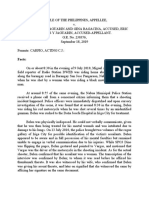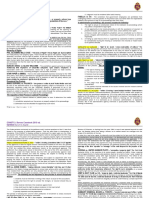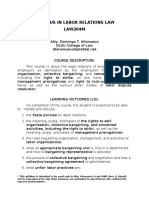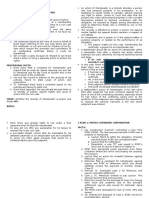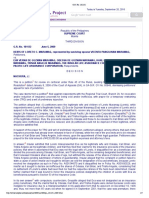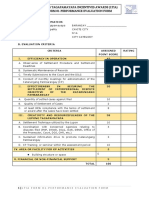People V Umanito
People V Umanito
Uploaded by
Anonymous fnlSh4KHIgCopyright:
Available Formats
People V Umanito
People V Umanito
Uploaded by
Anonymous fnlSh4KHIgOriginal Description:
Original Title
Copyright
Available Formats
Share this document
Did you find this document useful?
Is this content inappropriate?
Copyright:
Available Formats
People V Umanito
People V Umanito
Uploaded by
Anonymous fnlSh4KHIgCopyright:
Available Formats
PEOPLE V UMANITO
GR 172607
October 26, 2007
Facts:
AAA, then below 18 years of age, was accosted by
Umanito. He dragged her into the Home Economics
Building of Daramuangan Elementary School and
undressed her while holding a knife against her. He
set her down on a bench, put down the knife, and
had sex with her. He dressed up and threatened to
kill her if she reported the incident.
Six months later, AAA s mother noticed the
prominence on her stomach, and it was then that she
divulged to her mother the alleged rape. Her mother
brought her to the police station.
5 years later, Umanito was caught. He pleaded not
guilty.
RTC rendered judgment against Umanito and
sentenced
him
to
suffer reclusion
perpetua.
Umanito s appeal was transferred to the CA for
intermediate review, and CA affirmed.
Umanito seeks acquittal on reasonable doubt, with
the belated filing of the case and AAA s questionable
credibility as grounds, given that there were several
inconsistencies in her assertions. (nature of their
relationship, who took off her clothes, when he met
appellant, where the kissing happened)
Issue:
Whether or not the prosecution has successfully met
the level of proof needed to find the appellant guilty
of the crime of rape
Ruling:
No. Given the slew of assertions and counterassertions, the fact that AAA bore a child as a result
of the purported rape may provide the definitive key
to the absolution of Umanito.
With the advance in genetics and the availability of
new technology, it can now be determined with
reasonable certainty whether appellant is the father
of AAAs child.
o If it can be conclusively determined that
Umanito did not sire the child, this may cast a
shadow of reasonable doubt and allow his
acquittal on this basis.
AAA and her child are directed to submit themselves
to DNA testing under the aegis of the New Rule on
DNA Evidence (AM No. 06-11-5-SC), which took effect
on 15 Oct 2007 (a few days before promulgation of
this case).
DNA print/identification technology is now recognized
as a uniquely effective means to link a suspect to a
crime, or to absolve one erroneously accused, where
biological evidence is available. The groundwork for
acknowledging the strong weight of DNA testing was
first laid out in Tijing v. CA . Herrera v. Alba discussed
DNA analysis as evidence and traced the
development
of
its
admissibility
in
our
jurisdiction. Tecson v. COMELEC said that in case
proof of filiation or paternity would be unlikely to
establish, DNA testing could be resorted to.
The determination of whether or not Umanito is the
father (through DNA testing) is material to the fair
and correct adjudication of his appeal. Under Sec. 4
of AM No. 06-11-5-SC, the courts are authorized,
after due hearing and notice, motu proprio to order a
DNA testing. However, since SC is not a trier of facts,
it would be more appropriate that the case be
remanded to RTC for reception of evidence.
The hearing should be confined to ascertaining the
feasibility of DNA testing with due regard to the
standards set. RTC should order the DNA testing if it
finds it to be feasible in this case. RTC shall
determine the institution to undertake the testing,
and the parties are free to manifest their comments
on the choice. After the DNA analysis is obtained, it
shall be incumbent upon the parties who wish to
avail of the same to offer the results in accordance
with the rules of evidence, which shall be assessed
by RTC in keeping with Sections 7 (Assessment of
probative value of DNA evidence) and 8 (Reliability of
DNA testing methodology). RTC is also enjoined to
observe confidentiality and preservation of DNA
evidence.
To facilitate the execution of this resolution, although
the parties are primarily bound to bear the expenses
for DNA testing, such costs may be advanced by SC if
needed.
You might also like
- People vs. Vallejo DigestDocument2 pagesPeople vs. Vallejo DigestEdgar Joshua Timbang78% (9)
- People V Enojas - DigestDocument2 pagesPeople V Enojas - DigestCarlMarkInopia100% (6)
- 02 Tondo Medical V CADocument2 pages02 Tondo Medical V CAAnonymous fnlSh4KHIg75% (8)
- Gotham Pilot ScriptDocument60 pagesGotham Pilot ScriptAdrián Álvarez Muñoz100% (2)
- (Marcos Gold) Last Will and TestamentDocument8 pages(Marcos Gold) Last Will and TestamentRonald Wederfoort100% (3)
- Florida Ethics LetterDocument15 pagesFlorida Ethics LetterMAGA Inc.0% (1)
- Sasan, Sr. v. NLRC, Case DigestDocument1 pageSasan, Sr. v. NLRC, Case DigestJoshua Abad100% (1)
- Atienza v. Board of Medicine (Digest)Document3 pagesAtienza v. Board of Medicine (Digest)Tini Guanio80% (5)
- Pilipinas Shell Petroleum Corp. vs. Commissioner of CustomsDocument2 pagesPilipinas Shell Petroleum Corp. vs. Commissioner of CustomsCharmila SiplonNo ratings yet
- Mel Carpio Candelaria V. People of The Philippines G.R. No. 209386, December 8, 2014Document2 pagesMel Carpio Candelaria V. People of The Philippines G.R. No. 209386, December 8, 2014dasfghkjl100% (3)
- Jose Manuel Lezama vs. Hon. Jesus RodriquezDocument2 pagesJose Manuel Lezama vs. Hon. Jesus RodriquezMitchi Barranco100% (1)
- Case Digest - Sison VS PeopleDocument3 pagesCase Digest - Sison VS PeopleGladys Cañete100% (2)
- C3h - 2 People v. GatarinDocument2 pagesC3h - 2 People v. GatarinAaron Ariston100% (1)
- SUGAR REGULATORY ADMINISTRATION, v. TORMONDocument2 pagesSUGAR REGULATORY ADMINISTRATION, v. TORMONChilzia Rojas100% (3)
- Eagleridge V CameronDocument6 pagesEagleridge V CameronMareja ArellanoNo ratings yet
- 5th Sunday Prayer Card10242Document2 pages5th Sunday Prayer Card10242Germanicus MalmbergNo ratings yet
- People vs. UmanitoDocument2 pagesPeople vs. UmanitoMarie Bernadette BartolomeNo ratings yet
- DOCUMENTARY EVIDENCE Sison Vs PeopleDocument2 pagesDOCUMENTARY EVIDENCE Sison Vs PeopleAdi LimNo ratings yet
- Lejano v. PeopleDocument3 pagesLejano v. PeopleFncsixteen Ust0% (1)
- People v. Invencion Case Digest ShieDocument4 pagesPeople v. Invencion Case Digest Shielou017100% (1)
- People of The Philippines V Ronnie R. Librias G.R. No. 208067 September 14, 2016Document3 pagesPeople of The Philippines V Ronnie R. Librias G.R. No. 208067 September 14, 2016Jheanniver Nablo-PeñaNo ratings yet
- 02 People v. TanDocument2 pages02 People v. TanChen3xNo ratings yet
- Case Digest - People V QuidatoDocument2 pagesCase Digest - People V QuidatoCherry Chao100% (2)
- People v. LeeDocument4 pagesPeople v. LeeAnonymous XvwKtnSrMRNo ratings yet
- Case DigestDocument11 pagesCase Digestjoan mzi100% (1)
- PEOPLE OF THE PHILIPPINES v. RUDY NUYOKDocument2 pagesPEOPLE OF THE PHILIPPINES v. RUDY NUYOKannaNo ratings yet
- People v. YatarDocument4 pagesPeople v. Yatarrgtan3No ratings yet
- Pnoc Shipping and Transport Corporation VsDocument2 pagesPnoc Shipping and Transport Corporation VsJasper Meneses100% (1)
- DOCUMENTARY EVIDENCE People Vs TurcoDocument3 pagesDOCUMENTARY EVIDENCE People Vs TurcoAdi LimNo ratings yet
- G.R. Nos. 116196-97. June 23, 1999 PEOPLE OF THE PHILIPPINES, Plaintiff-Appellee, vs. PABLO ADOVISO, Defendant-AppellantDocument3 pagesG.R. Nos. 116196-97. June 23, 1999 PEOPLE OF THE PHILIPPINES, Plaintiff-Appellee, vs. PABLO ADOVISO, Defendant-AppellantTootsie GuzmaNo ratings yet
- DST MOVERS CORPORATION V PGICDocument3 pagesDST MOVERS CORPORATION V PGICTrem Gallente100% (2)
- People v. Ramos (2018)Document6 pagesPeople v. Ramos (2018)Horeb Felix VillaNo ratings yet
- Case Digest Alvarez Vs RamirezDocument2 pagesCase Digest Alvarez Vs Ramirezowen100% (1)
- Peltan vs. CADocument2 pagesPeltan vs. CAcharmdelmoNo ratings yet
- Marcos Vs Heirs of NavarroDocument2 pagesMarcos Vs Heirs of NavarroRal Tibs100% (2)
- People Vs YatarDocument2 pagesPeople Vs YatarLaika Corral50% (2)
- Custodio V SandiganbayanDocument2 pagesCustodio V SandiganbayanJonathan Dancel50% (2)
- Object, Docu and Testimonial Evidence CasesDocument37 pagesObject, Docu and Testimonial Evidence CasesJezreel CastañagaNo ratings yet
- FABI - Cases For Authentication and Proof of DocumentsDocument2 pagesFABI - Cases For Authentication and Proof of DocumentsG FNo ratings yet
- PP Vs GallenoDocument2 pagesPP Vs GallenoPam Otic-Reyes100% (2)
- Heirs of Prodon vs. Heirs of AlvarezDocument2 pagesHeirs of Prodon vs. Heirs of AlvarezShane Fernandez JardinicoNo ratings yet
- Nepomuceno Vs Lopez Case DigestDocument2 pagesNepomuceno Vs Lopez Case DigestCarol Jacinto100% (1)
- GR No. 177407 - DigestDocument2 pagesGR No. 177407 - DigestLeopoldo, Jr. Blanco100% (1)
- People Vs CarpoDocument2 pagesPeople Vs CarpoGabriel Antonio ZuluetaNo ratings yet
- Aldeguer Vs Hoskyn. GR No. 1164 September 17 1903Document3 pagesAldeguer Vs Hoskyn. GR No. 1164 September 17 1903eunice demaclidNo ratings yet
- 05 BE San Diego vs. CADocument5 pages05 BE San Diego vs. CAMarc Edmer MercadoNo ratings yet
- State Prosecutors Vs Judge MuroDocument3 pagesState Prosecutors Vs Judge MurooabeljeanmoniqueNo ratings yet
- 02 Sison V PeopleDocument3 pages02 Sison V PeopleCedric EnriquezNo ratings yet
- People Vs Yatco DigestDocument2 pagesPeople Vs Yatco DigestG FNo ratings yet
- Torralba v. PPDocument2 pagesTorralba v. PPAntonJohnVincentFrias0% (1)
- People Vs YatarDocument2 pagesPeople Vs YatarJunivenReyUmadhay100% (1)
- People Vs MalimitDocument2 pagesPeople Vs MalimitAya Baclao100% (2)
- C3h2 - 1 People v. AbriolDocument2 pagesC3h2 - 1 People v. AbriolAaron AristonNo ratings yet
- People v. InvencionDocument4 pagesPeople v. InvencionkathrynmaydevezaNo ratings yet
- Herrera v. AlbaDocument2 pagesHerrera v. AlbaNoreenesse Santos100% (1)
- Herrera v. Alba - DigestDocument3 pagesHerrera v. Alba - Digestkathrynmaydeveza100% (1)
- Lazaro v. Agustin DIGESTDocument4 pagesLazaro v. Agustin DIGESTkathrynmaydevezaNo ratings yet
- PP v. Eric VargasDocument3 pagesPP v. Eric VargasAARON JOHN VIRAY100% (1)
- PP v. Estibal - Case DigestDocument1 pagePP v. Estibal - Case Digestshezeharadeyahoocom100% (3)
- Rimorin V People - DigestDocument1 pageRimorin V People - DigestJoshua Abad0% (1)
- C3h - 3 People v. PalanasDocument2 pagesC3h - 3 People v. PalanasAaron AristonNo ratings yet
- PP v. Constancio - Case DigestDocument2 pagesPP v. Constancio - Case Digestshezeharadeyahoocom100% (2)
- People of The Philippines v. Saiben LangcuaDocument3 pagesPeople of The Philippines v. Saiben Langcua楊瑪莉No ratings yet
- Digest - People Vs AdovisoDocument2 pagesDigest - People Vs Adovisoanntomarong83% (6)
- 048 - People v. Umanito (2007) (Villarey)Document2 pages048 - People v. Umanito (2007) (Villarey)Third VillareyNo ratings yet
- Consolidated Bar Tips, Batch 2015Document16 pagesConsolidated Bar Tips, Batch 2015Anonymous fnlSh4KHIg100% (6)
- Instrument Is Incomplete and Revocable Until Delivery ofDocument5 pagesInstrument Is Incomplete and Revocable Until Delivery ofAnonymous fnlSh4KHIgNo ratings yet
- AIRPHIL V PenswellDocument11 pagesAIRPHIL V PenswellAnonymous fnlSh4KHIgNo ratings yet
- Consti II Digests JechDocument179 pagesConsti II Digests JechJoseph RicaldeNo ratings yet
- 07 Ftwu V Minister of LaborDocument2 pages07 Ftwu V Minister of LaborAnonymous fnlSh4KHIgNo ratings yet
- Digests - Consti 2 Casebook 2010 EdDocument81 pagesDigests - Consti 2 Casebook 2010 EdAnonymous fnlSh4KHIg100% (1)
- Digest Author: Abata, Marivir GDocument2 pagesDigest Author: Abata, Marivir GAnonymous fnlSh4KHIgNo ratings yet
- 11 Funa V MecoDocument2 pages11 Funa V MecoAnonymous fnlSh4KHIg100% (2)
- DOTC-DTI Joint Administrative Order No. 1, S. 2012: GOVPH (/)Document22 pagesDOTC-DTI Joint Administrative Order No. 1, S. 2012: GOVPH (/)Anonymous fnlSh4KHIgNo ratings yet
- 08 Guingona JR V CaragueDocument3 pages08 Guingona JR V CaragueAnonymous fnlSh4KHIgNo ratings yet
- Syllabus in Labor Relations Law LAW204MDocument28 pagesSyllabus in Labor Relations Law LAW204MAnonymous fnlSh4KHIgNo ratings yet
- 2 PNR V Vizcara - PanganibanDocument2 pages2 PNR V Vizcara - PanganibanAnonymous fnlSh4KHIgNo ratings yet
- Ramiro & PM ReyesDocument6 pagesRamiro & PM ReyesAnonymous fnlSh4KHIgNo ratings yet
- Warsaw PDFDocument7 pagesWarsaw PDFAnonymous fnlSh4KHIgNo ratings yet
- WeigandDocument73 pagesWeigandAnonymous fnlSh4KHIgNo ratings yet
- 1 Ong v. Metropolitan Water District MPDocument3 pages1 Ong v. Metropolitan Water District MPAnonymous fnlSh4KHIgNo ratings yet
- 1 Interpleader Cases 1 10Document11 pages1 Interpleader Cases 1 10Anonymous fnlSh4KHIgNo ratings yet
- Law Philippines - Case Digest - Holy Child Catholic School v. Hon. StoDocument4 pagesLaw Philippines - Case Digest - Holy Child Catholic School v. Hon. StoAnonymous fnlSh4KHIgNo ratings yet
- Lazatin, Raphaela Kercee Vendel P. G02: FactsDocument6 pagesLazatin, Raphaela Kercee Vendel P. G02: FactsAnonymous fnlSh4KHIgNo ratings yet
- 11 21Document34 pages11 21Anonymous fnlSh4KHIgNo ratings yet
- Today Is Tuesday, September 20, 2016Document7 pagesToday Is Tuesday, September 20, 2016Anonymous fnlSh4KHIgNo ratings yet
- Godines V CADocument1 pageGodines V CAAnonymous fnlSh4KHIgNo ratings yet
- TM Application Form 101016Document1 pageTM Application Form 101016Anonymous fnlSh4KHIgNo ratings yet
- HLS Student Government ConstitutionDocument9 pagesHLS Student Government ConstitutionAnonymous fnlSh4KHIgNo ratings yet
- Traditional Project Modern Project ManagementDocument5 pagesTraditional Project Modern Project ManagementRas Abel BekeleNo ratings yet
- Raz La31 FruitcolorsDocument12 pagesRaz La31 FruitcolorsgggNo ratings yet
- GE 8 Ethics BEEDDocument5 pagesGE 8 Ethics BEEDKristel Peralta OfracioNo ratings yet
- Balaji Dora Plasticsfinal PrintoutDocument67 pagesBalaji Dora Plasticsfinal PrintoutMichael WellsNo ratings yet
- Business Opportunity IdentificationDocument3 pagesBusiness Opportunity Identificationmd fahadNo ratings yet
- Ukay Ukay Culture in The Philippines RRLDocument4 pagesUkay Ukay Culture in The Philippines RRLYsabel SorianoNo ratings yet
- Point Blank Incident ReportDocument35 pagesPoint Blank Incident ReportThe News-HeraldNo ratings yet
- A Glass Top Centre TableDocument7 pagesA Glass Top Centre TableTatiana ChewNo ratings yet
- MD Ruhul AminDocument4 pagesMD Ruhul Aminapi-506705816No ratings yet
- Is An Intensive Outpatient ProgramDocument1 pageIs An Intensive Outpatient ProgramJack williamNo ratings yet
- Use of Power Under Section 156 (3) Cr.P.C.Document5 pagesUse of Power Under Section 156 (3) Cr.P.C.Krishna KumarNo ratings yet
- Telecom Sector in IndiaDocument8 pagesTelecom Sector in Indiasaurabhpandey30No ratings yet
- Hub Spoke Model 10112023Document2 pagesHub Spoke Model 10112023Gaurang BhattNo ratings yet
- ATTBill 0708 Sep2023Document4 pagesATTBill 0708 Sep2023Franklin morelNo ratings yet
- Legal Basis andDocument93 pagesLegal Basis andKhryzza Queen SinsuatNo ratings yet
- 2019 USC - Boeing Design ChallengeDocument10 pages2019 USC - Boeing Design Challengeash krisNo ratings yet
- Annex H Summary List of Beneficiaries Version 3Document4 pagesAnnex H Summary List of Beneficiaries Version 3Glenda Osia-DiazNo ratings yet
- WPS UaeDocument38 pagesWPS UaebunklyNo ratings yet
- CUP OF JERUSALEM by Wendy Chasteen Index ADocument7 pagesCUP OF JERUSALEM by Wendy Chasteen Index Aapi-182886101No ratings yet
- JEn AppointmentDocument9 pagesJEn Appointmenthappy singhNo ratings yet
- ANNEX A - LTIA Technical NotesDocument3 pagesANNEX A - LTIA Technical NotesJollina MabonggaNo ratings yet
- Grade 12 Civics 3rd Round Model ExamDocument12 pagesGrade 12 Civics 3rd Round Model Examአኒቶ መንገሻ94% (16)
- Rhine y La ParapsicologiaDocument8 pagesRhine y La ParapsicologiaNoe GallegosNo ratings yet
- Internship ReportDocument10 pagesInternship ReportAbel Ebin0% (1)
- Cause and Effect ParagraphDocument5 pagesCause and Effect ParagraphArgenis AlmanzarNo ratings yet
- 3 - Employer AssociationsDocument6 pages3 - Employer AssociationsOnkar ShindeNo ratings yet

























































